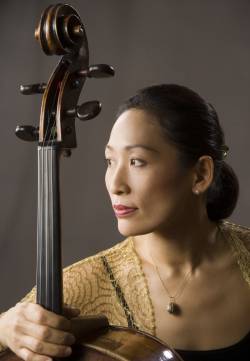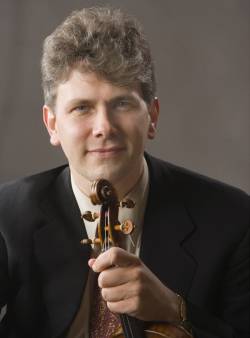Concert Review: Nicholas Kitchen and Yeesun Kim at the Worcester Art Museum
WAM’s Chamber Music Series is a model for what chamber music performance ought to be: excellent musicians performing in a small space with a rather informal air to the proceedings.
Music for String Duo. Violinist Nicholas Kitchen and cellist Yeesun Kim from the internationally acclaimed Borromeo String Quartet. At Worcester Arts Museum, Worcester, MA, March 18.
By Jonathan Blumhofer.
Violinist Nicholas Kitchen and cellist Yeesun Kim, who between them make up half of the famed Borromeo String Quartet, presented a creatively planned and passionately executed program of all-twentieth century repertoire for violin and cello Sunday afternoon at the Worcester Art Museum (WAM). Their recital, part of WAM’s Chamber Music Series, featured solos and duets by Ernest Bloch, Erwin Schulhoff, Eugene Ysaÿe, and Zoltán Kodály.
Sponsored by a gift from Nydia and Charles Moser, WAM’s Chamber Music Series is a model for what chamber music performance ought to be: excellent musicians performing in a small space that gives the proceedings a rather informal air. Mr. Kitchen provided spoken introductions to three of the pieces and also talked a bit about his and Ms. Kim’s use of technology in performance (they read their parts off of a couple of Apple laptops). At intermission David Acton, the Museum’s curator of prints, drawings, and photographs, treated the audience to a brief art lecture. Afterward, there were desserts provided by one of central Massachusetts’s fine bakeries, The Bean Counter. All in all, it was a very pleasant way to pass a couple of hours on a Sunday afternoon.
At the heart of it was the music. Together Mr. Kitchen and Ms. Kim have developed a fine rapport as colleagues in the Borromeo, and this quality was borne out in their playing of the duet items on the program. It may be superfluous to mention it, but both are also superb soloists, as was demonstrated in performances of Bloch’s Suite no. 1 for Cello Solo and Ysaÿe’s Solo Violin Sonata no. 4.
Perhaps the best-known works on the program fell in the concert’s second half: Ysaÿe’s aforementioned Sonata and Kodály’s rustic Duo for violin and cello. Ysaÿe wrote six of these Sonatas, each dedicated to a major virtuoso of the day (the fourth is dedicated to Fritz Kreisler) and all recalling—to varying degrees—the seminal solo violin sonatas and partitas of Bach. The fourth Sonata falls into three movements: a stern opening Allemande, a lyrical Sarabande, and a moto perpetuo finale.
Mr. Kitchen gave the piece a committed performance that was notable for its emphasis on Ysaÿe’s contrapuntal textures. The outer movements, which generally alternate arpeggiated passages with sections of double-, triple-, and quadruple-stops, were nice and steely: characterful violin music played with a striking combination of fearlessness and sensitivity. The Sarabande, into each measure of which Ysaÿe incorporated a four-note, basso lamento pattern, formed a peaceful interlude.
Born in 1882, Kodály was Bartòk’s contemporary and his colleague at the Liszt Academy in Budapest. Both composers were among the pioneers of ethnomusicology, traveling widely throughout Eastern Europe in the first decades of the twentieth century collecting and recording huge quantities of folk music. These folk influences played a significant role in their compositions, as the present Kodály score attests.
Bartòk’s influence, particularly that of his String Quartet no. 1 (1908), also looms large on Kodály’s Duo, written six years later in 1914. The Duo falls into three movements, the first two on the slower side, while the finale, after an operatic recitative, is vigorously energetic. Sunday’s performance featured some spiritedly aggressive playing from both Mr. Kitchen and Ms. Kim that may not be to all tastes—I wouldn’t have minded a softer edge to parts of the first two movements—but it certainly made for an exciting reading. The finale, with its quirky quotations of folk material came off the best, though both instrumentalists realized the violent expressive shifts in the Duo’s second movement with great drama.
The program’s other duet, Schulhoff’s 1925 Duo, was a revelation. Of late, Schulhoff, who died in a Nazi concentration camp in 1942, has become an increasingly frequent presence on concert programs, and that is a good thing; still, with pieces like this, one wonders why it’s taken so long. The Duo is a compendium of virtuoso instrumental techniques popular in the 1920s and later (including left-hand pizzicato and extended passages of artificial harmonics) married to a richly chromatic harmonic vocabulary that is also heavily influenced by folk music. Dedicated to Leoš Janáček, the Duo references some of the older composer’s compositional techniques in its second movement.
Mr. Kitchen and Ms. Kim were perfectly at home in Schulhoff’s style, gamely dialoguing with one another as the piece proceeded. The Janáček-influenced second movement was played with hearty abandon, while the song-like third movement encouraged both players to showcase their lyrical capabilities. In the finale, a slow introduction that seems to recall Ravel gives way to an explosive coda that, on Sunday, was taken at a breathtaking clip. Throughout the piece, Mr. Kitchen and Ms. Kim’s ensemble playing was remarkable: not only did the conversational aspects of the score come across but their perfect unity in other sections of the piece made for a most remarkable performance. Perhaps the full Borromeo Quartet will soon undertake a survey of Schulhoff’s excellent string quartets? I certainly hope so.
To open Sunday’s concert, Ms. Kim and her 1576 Peregrino Zanetto cello performed Bloch’s 1956 Suite. Today, Bloch isn’t nearly as widely known as he was during his lifetime: he was one of the leading composers and teachers of the first half of the twentieth century, often grouped together with the likes of Schoenberg, Hindemith, Bartòk, and Webern, among others. This brief Suite clearly references the first Bach Cello Suite at a couple of points and on the whole is an engaging, thoroughly ingratiating piece.
In Ms. Kim’s hands, Bloch’s dark-hued textures glowed luminously, particularly in the opening Prelude and the third movement Canzona. The brisk second and fourth movements bounced along energetically and, in the rather rollicking finale especially, with more than a little charm.
Tagged: Borromeo String Quartet, Nicholas Kitchen, WAM’s Chamber Music Series, Worcester Arts Museum


